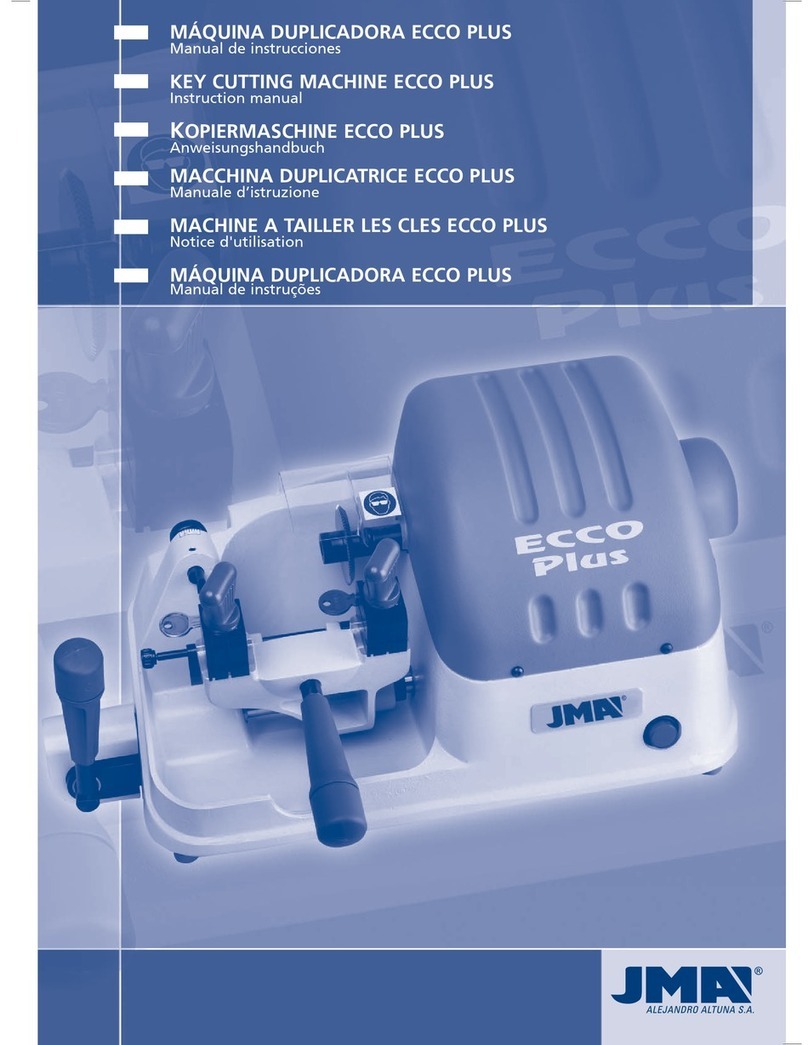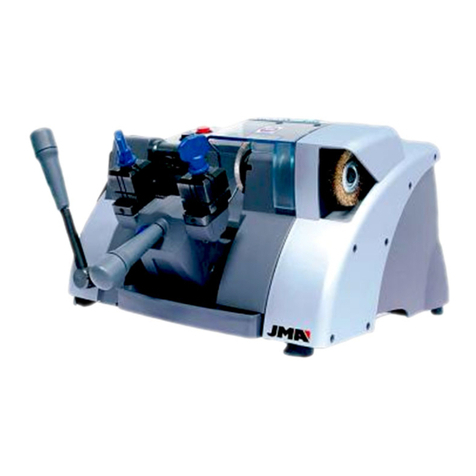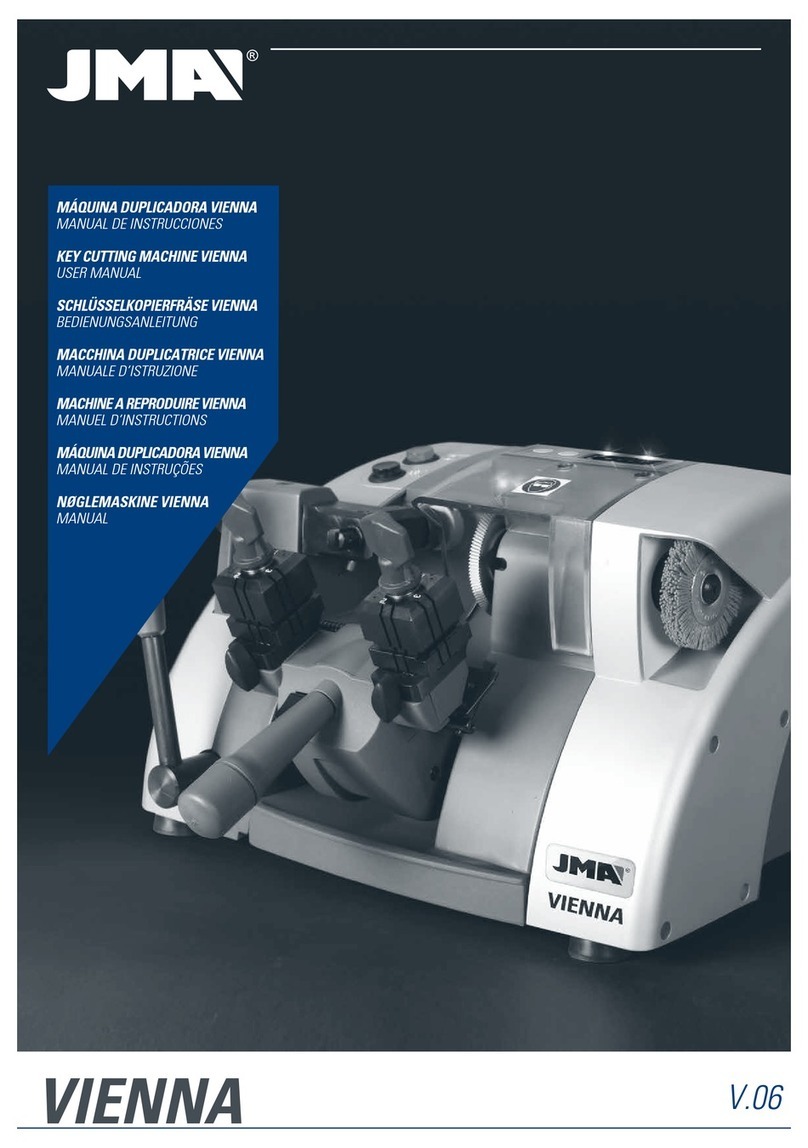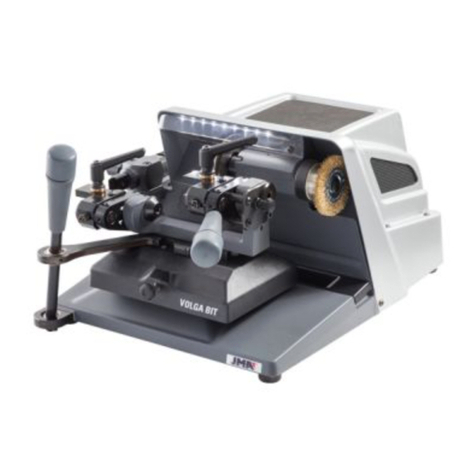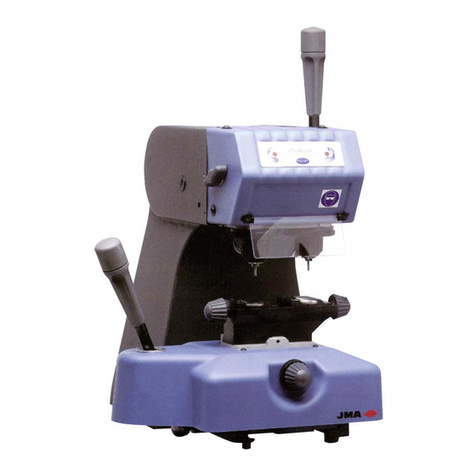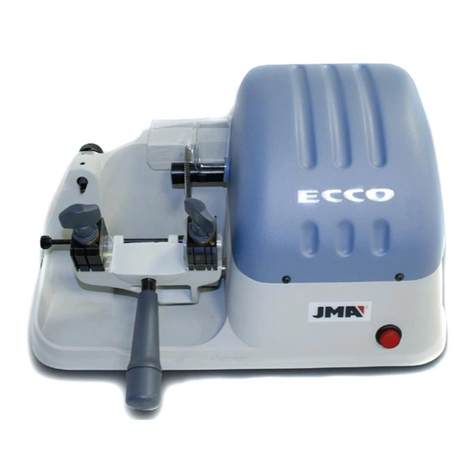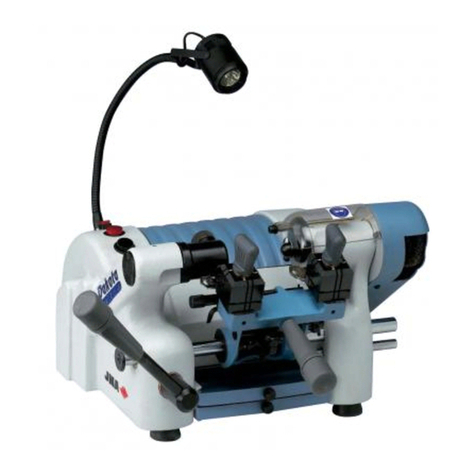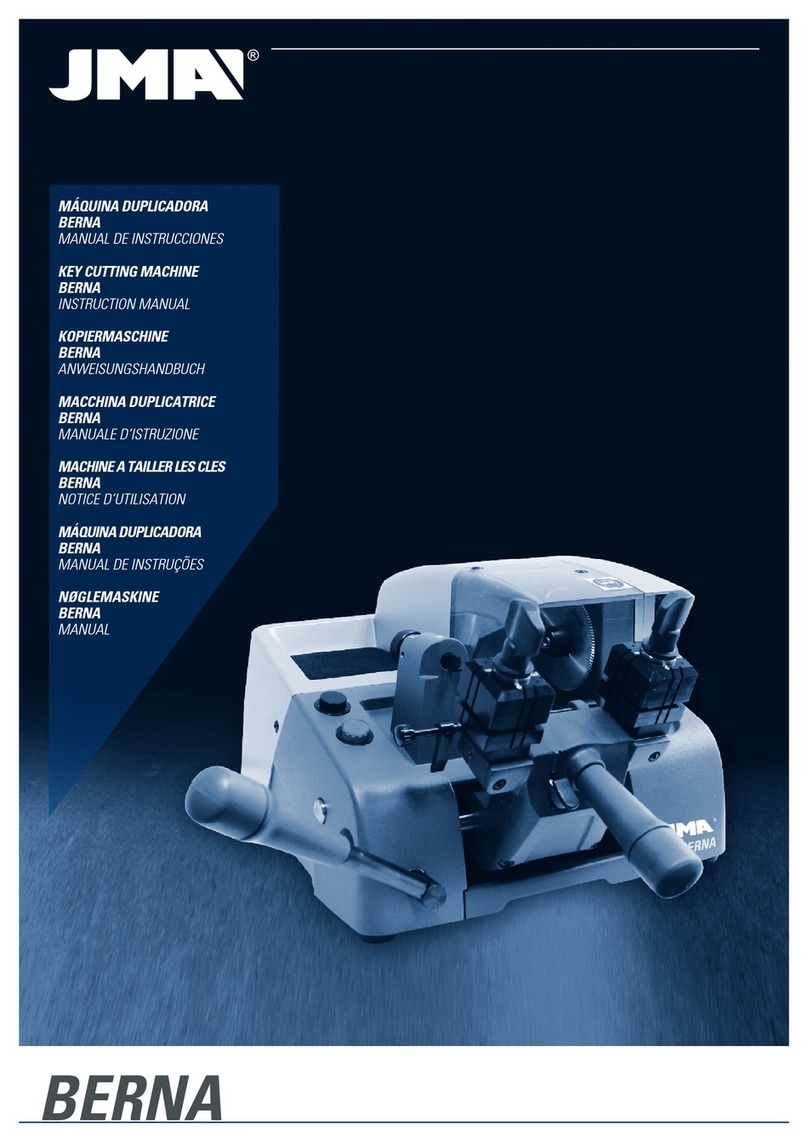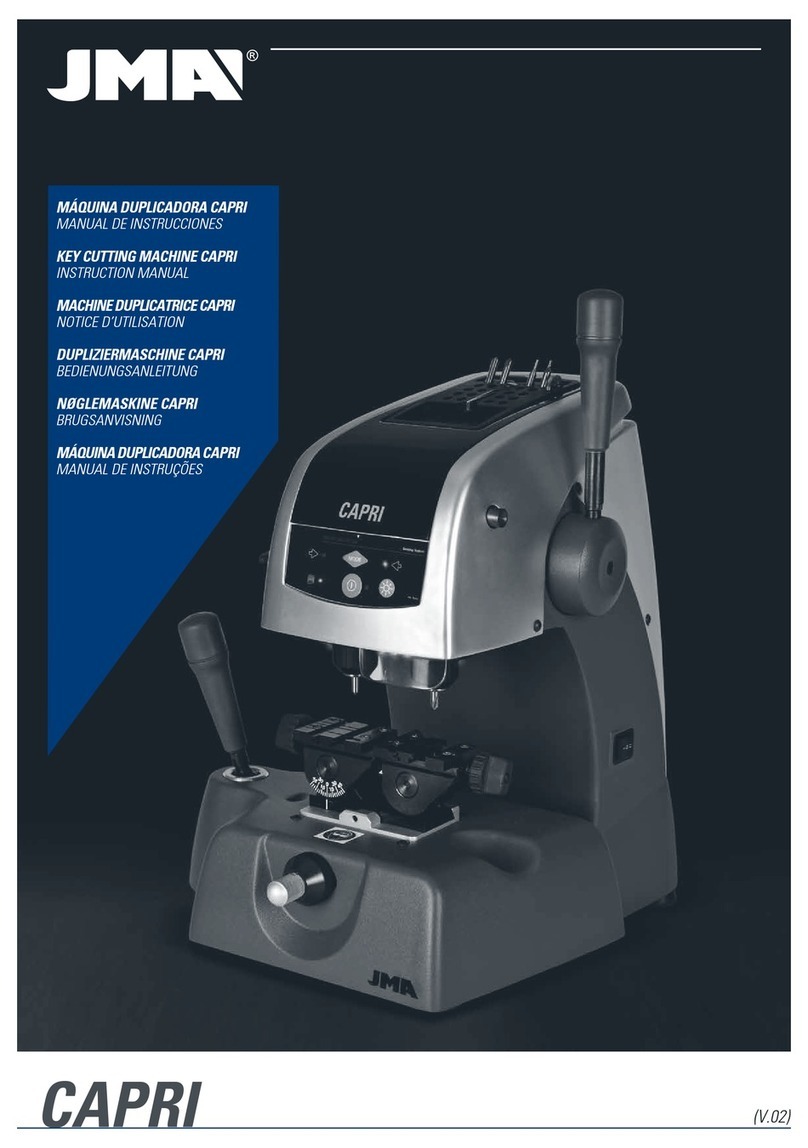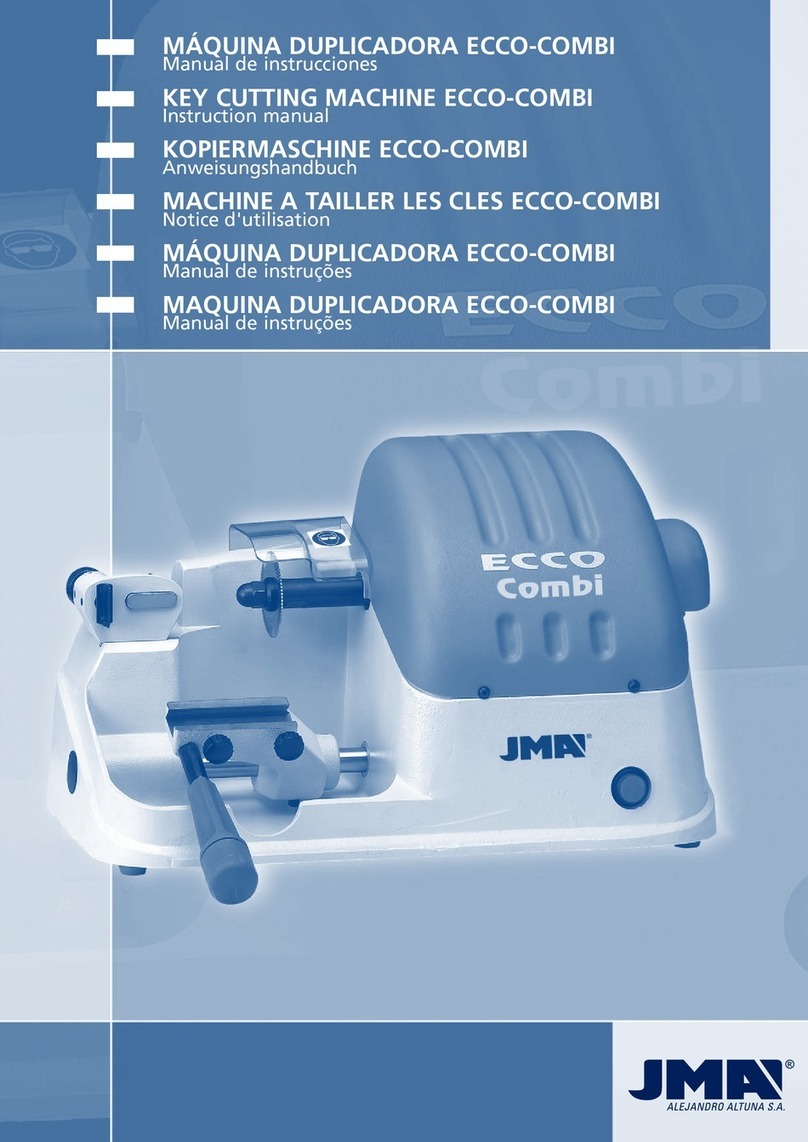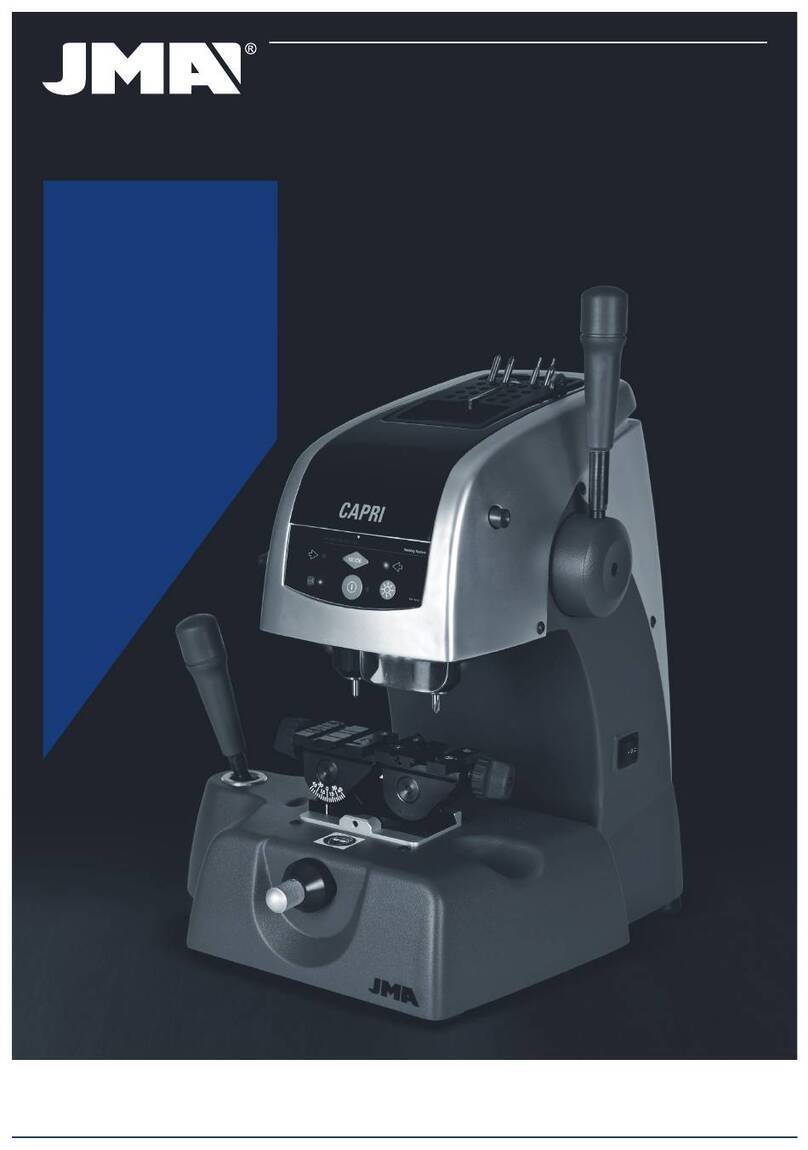JMA SENA User manual

1
SENA
INSTRUCTION MANUAL(V02)

1
1
CONTENTS:
1PRESENTATION AND GENERAL ASPECTS.....................................................................2
1.1 GENERAL POINTS..................................................................................................................2
1.2 TRANSPORT AND PACKING .................................................................................................2
1.3 IDENTIFICATION LABEL.........................................................................................................2
2CHARACTERISTICS OF THE MACHINE...........................................................................3
2.1 FAMILY OF KEYS ...................................................................................................................3
2.2 PARTS OF THE KEY................................................................................................................5
2.3 TECHNICAL INFORMATION ..................................................................................................5
2.4 MAIN ELEMENTS OF THE MACHINE ...................................................................................6
2.5 PRELIMINARY OPERATIONS AND WARNINGS...................................................................7
2.5.1 Installing the levers ................................................................................................................................. 8
2.6 COMPONENTS AND FUNCTIONAL PARTS ..........................................................................9
2.6.1 Accessories.............................................................................................................................................. 9
2.6.2 Electric circuit ........................................................................................................................................ 10
3HOW TO OPERATE THE MACHINE ..............................................................................11
3.1 MACHINE ADJUSTMENT ...................................................................................................11
3.1.1 Adjustment of the tracer point. ............................................................................................................. 11
3.2 KEY CUTTING ......................................................................................................................13
3.2.1 Cutting bit keys...................................................................................................................................... 13
3.2.2 Cutting pump keys and Muel type keys. ............................................................................................... 14
3.2.2.1 Pump keys.............................................................................................................................................................14
3.2.2.2 Muel type keys. ....................................................................................................................................................15
3.2.3 Cutting vertical groove keys, wedge bit mortice and ADPLE1,2,3,4 keys............................................. 16
4MAINTENANCE AND SAFETY .....................................................................................17
4.1 CHANGING THE CUTTER OR THE BRUSH ..........................................................................17
4.2 CHANGING THE TRACER POINT.........................................................................................18
4.3 ADJUSTING THE CLAMPS..................................................................................................18
4.3.1 Single and double bladed bit key clamp cutting depth adjustment...................................................... 18
4.3.2 Pump key and vertical groove key clamp cutting depth adjustment..................................................... 19
4.3.3 Bit key clamp side adjustment. ............................................................................................................. 20
4.3.4 Pump key and vertical groove key clamp side adjustment ................................................................... 21
4.4 TIGHTENING OR REPLACING THE BELT .............................................................................23
4.5 REPLACING THE LAMP .......................................................................................................24
4.6 CLEANING THE MACHINE. .................................................................................................24
4.7 SAFETY RECOMMENDATIONS...........................................................................................24
5WASTE DISPOSAL ......................................................................................................25
5.1 PACKING..............................................................................................................................25
5.2 SWARF ................................................................................................................................25
5.3 MACHINE ............................................................................................................................25

2
2
1PRESENTATION AND GENERAL ASPECTS
1.1 GENERAL POINTS
The SENA key cutting machine has been designed on the basis of the safety standards
currently in force in the EU.
The safety of the personnel involved in the handling of this type of machines can only be
achieved with a well designed worker safety programme, like the implementation of a
maintenance programme and following recommended advice as well as compliance with
the safety standards included in this manual.
Although the machine is not difficult to install, it is best not to try to install, adjust or use it
without having first read this manual.
The machine leaves our factory ready for use and only requires calibration operations for
the tools that are going to be used.
1.2 TRANSPORT AND PACKING
The machine comes inside packing with the following dimensions:
Width = 520 mm, length = 600 mm, height = 500mm
Weight of machine plus packing = 55 Kg.
When you unpack the machine, check carefully if it has suffered any damage during
transportation. If you find any problems, please inform the carrier immediately and do not
do anything with the machine until the carrier’s agent has carried out an inspection.
1.3 IDENTIFICATION LABEL
The SENA key cutting machine has an identification label, specifying the serial number,
manufacturer’s name and address, the CE mark and the year of manufacture.

3
3
2CHARACTERISTICS OF THE MACHINE
The SENA key cutting machine is a professional semi-automatic key cutting machine.
It has been prepared to cut single and double bladed bit keys, pump keys, Muel type keys and
vertical groove keys. The machine’s design enables all the models of key mentioned to be cut
without having to change the slide, only having to move the slide to the correct position. These
characteristics make it a versatile machine.
The clamps have been designed to ensure that the keys are clamped correctly. Flat keys and
wedge bit mortice keys can be cut.
The clamp-holder slide is mounted on guides that slide on roller cages. This system provides the
machine with maximum precision, rigidity and sensitivity when it is being used.
Asynchronous motor with two speeds which provides greater flexibility when cutting keys
(speed1: steel, speed2: brass).
It also has an adjustable lamp to light any area of the machine and a brush for removing burrs on
the key.
2.1 FAMILY OF KEYS
The SENA machine can cut the following types of keys:
•Single and double blade bit keys.

4
4
•Pump keys with flat or cylindrical stems, Muel type keys.
•Keys with vertical grooves, wedge bit mortice and ADPLE-1-2-3-4 keys.

5
5
2.2 PARTS OF THE KEY
1. Head
2. Stem
3. Blade
4. Teeth
2.3 TECHNICAL INFORMATION
The main technical information is given below:
Motor: Single phase, 2 speeds 2800-1400 rpm, 220V/ 50HZ, 0.55-0.37Kw
Cutter: Hard metal ∅80 x 16 x1,5 mm.
Clamps: 3 models
Displacement: Guides with roller cage.
Dimensions: Width = 300 mm, Depth = 550 mm,
Height = 350 mm.
Weight: 50 Kg.
1
2
3
4

6
6
2.4 MAIN ELEMENTS OF THE MACHINE
1. Cutter.
2. Brush.
3. Tracer.
4. Tracer support.
5. Tracer adjustment control.
6. Light switch.
7. ON/OFF switch.
8. Motor with ON/OFF selector.
9. Belt protector.
10. Cutter protector.
11. Lever.
12. Lever to turn moving clamp for single / double bladed keys.
13. Lever to move moving clamp for pump keys.
14. Blocking shaft for moving clamp for single / double bladed
keys.
15. Clamp-holder slide blocking knob.
16. X slide blocking knob.
17. Y slide blocking knob.
18. Fixed clamp for single /double bladed keys.
19. Single / double bladed key clamping fixed clamp knob.
20. Single / double bladed key moving clamp.
21. Single / double bladed key clamping moving clamp knob.
22. Pump key and vertical groove key fixed clamp.
23. Pump key clamping fixed clamp knob.
24. Vertical groove key clamping fixed clamp knob.
25. Pump and vertical groove key moving clamp.
26. Pump key clamping moving clamp knob.
27. 1 key clamping moving clamp knob
28. X and Y stop.
29. Clamp-holder slide.
30. Lamp.

7
7
2.5 PRELIMINARY OPERATIONS AND WARNINGS.
Place the machine on a solid table that will withstand the weight, bearing in mind that the line
and machine voltage must be the same.
The machine has been tested at our facilities before being sent out.
Before starting up the machine and carrying out any operation, block the X and Y slides with
controls 16 and 17.
The key clamping operations and slide movements must be carried out with the machine switched
off.
Positions on the clamp-holder slide:
Sliding the slide on the dovetail, position one of the three reference points Rwith the base
reference point S.
•The first reference point R1 is for cutting single and double bladed bit keys.
•The second reference point R2 is for cutting pump keys and Muel type keys.
•The third reference point R3 is for cutting keys with vertical grooves, wedge bit mortice
and ADPLE1,2,3,4 keys.
Once the slide is in the correct position, block it by turning the knobs (15).
15
S
R1 R2 R3

8
8
Remember that the machine has two speeds:
0
12
When starting up the machine, press the start button (7) and turn the motor selector to
speed 1 or 2. Once the cutting operation has been completed, set the selector to the 0 position
and press the button (7) again to completely switch off the machine.
2.5.1 Installing the levers
•Fitting levers 12 and 13
Screw the lever (12 and 13) to the right position and tighten the nut.
12 13
SPEED 1= STEEL 700 rpm
SPEED 2 = BRASS 1400 rpm

9
9
2.6 COMPONENTS AND FUNCTIONAL PARTS
2.6.1 Accessories
12
3
4
5
6
8
7
9
1. ∅7x70 rod for changing the cutter.
2. Size 18 spanner.
3. Set of allen keys (2.5, 3, 4, 5, 6).
4. Side adjustment pieces.
5. ∅6x70 cutting depth adjustment rod.
6. Key stop plate.
7. 1mm thick tracer.
8. Ø80x1x16 cutter.
9. Front adjustment pieces.
For cutting keys with machining equal to or smaller than 1mm.
Table of contents
Other JMA Cutter manuals
Popular Cutter manuals by other brands

Bosch
Bosch POF 1400 ACE Original instructions

SignWarehouse.com
SignWarehouse.com Bobcat BA-60 user manual

Makita
Makita 4112HS instruction manual

GEISMAR STUMEC
GEISMAR STUMEC MTZ 350S manual

Hitachi
Hitachi CM 4SB2 Safety instructions and instruction manual

Dexter Laundry
Dexter Laundry 800ETC1-20030.1 instruction manual
